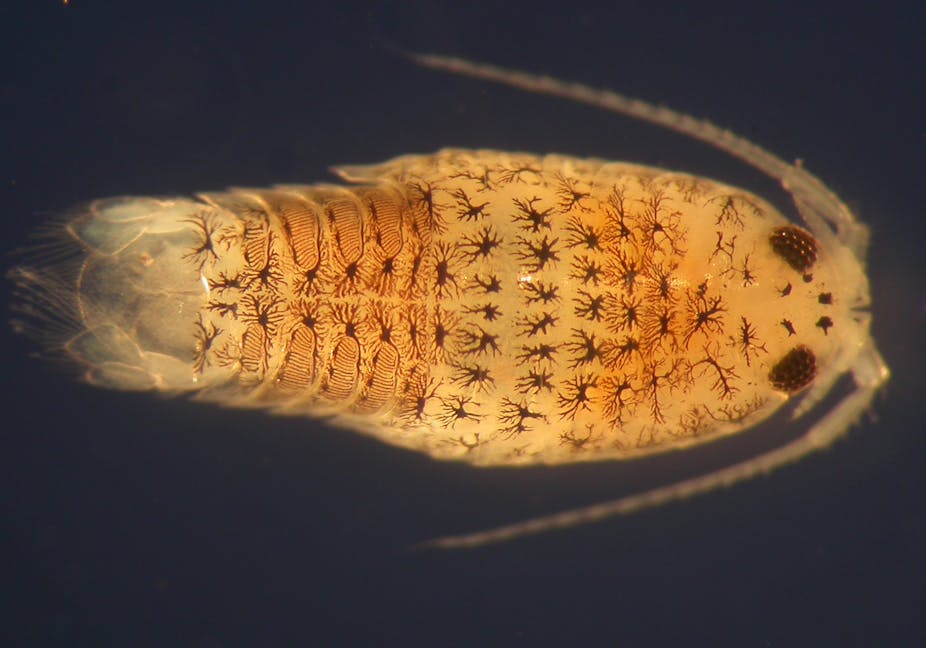You get hauled out of bed in the morning not just because of an alarm clock. We are genetically encoded with a 24-hour (circadian) body clock that allows us to live in harmony with our environment. But marine creatures have a far more complex environment to manoeuvre. New research published in Current Biology has shown that coastal animals have a genetic tidal timer which is independent of their 24-hour body clock.
The researchers observed the behaviour of Eurydice pulchra, the speckled sea louse which lives along the sandy British shores. The creatures’ swimming cycle is based on a 12.4-hour clock, as it has to match the tides; they swim to find food as the tide comes in, and bury themselves in the sand as it goes out. But they are also subject to our 24-hour rhythm: pigmented cells called melanophores grow during the day to act as sunscreen, and become smaller at night when they are not needed.
Scientists have known for more than 50 years that most organisms have an internal timing mechanism with a period of about 24 hours. John O'Neill, a molecular biologist at the University of Cambridge, explained how deeply ingrained it is.
“The daily biological rhythm can be observed in every cell of the human body, and even persists indefinitely in vitro,” he said. “For example, I could culture a scraping of your skin cells in a petri dish, and they would continue to exhibit a circadian rhythm in gene expression and metabolism, despite the fact that the cells would have no idea what time of day it is externally, as they lack photoreceptors.”
These circadian clocks are hard-wired into our physiology. And this is the only major environmental variation that most organisms have to respond to. However, coastal creatures also have the varying tides to deal with. They have evolved to be better adapted to their environment by successfully negotiating these tides.
“It has been established for many years that circatidal rhythms exist,” said O'Neill. But it was assumed that the tidal body clock was determined by the circadian “master” clock. “This paper revisits a really interesting phenomenon, and finally solves a long-standing controversy,” O'Neill continued.
The team was able to “turn off” Eurydice’s circadian clock, and thereby demonstrate the independence of the tidal clock mechanism. Charalambos Kyriacou, one of the researchers, explained how. “We blocked the circadian clock of Eurydice in two ways,” he said. “By giving the animals constant intense bright light the 24-hour circadian clock was disrupted, but the tidal 12.4-hour clock, which is reflected in the animals swimming rhythms, remained intact. We also blocked the 24-hour clock genetically, by interfering with a key clock molecule directly.”
But the tidal swimming rhythm kept on ticking: there would be a flurry of swimming activity every 12.4 hours in the Eurydice‘s dark seawater tubes. The researchers therefore conclusively demonstrated that the Eurydice’s two body clocks are entirely genetically independent of one another.
These results, along with a parallel study on coastal worms published simultaneously in the journal Cell Reports which came to a similar conclusion, imply that this is widespread. “I expect tidal rhythms in many coastal organisms will follow this rule,” said Kyriacou, “including insects, crabs, even plants.”
O'Neill discussed what future research this might allow. “The next big question the authors need to answer is how exactly this circatidal rhythm works,” he said. “If the distinct circuits that respond to and regulate tidal and circadial rhythms could be isolated and understood, as well as the interactions between the two circuits, then we could learn some very interesting general principles. For example, about how the brain integrates environmental information, and then generates the appropriate behavioural and physiological response. This would definitely be relevant to understanding similar, though more complex, human behaviours.”
This might allow us to better understand how different clock systems interact and influence behaviour. “There is some evidence that humans alter their behaviour during the lunar cycle,” said Kyriacou. Perhaps humans have an independent circalunar clock that influences our behaviour, in ways yet unknown.

